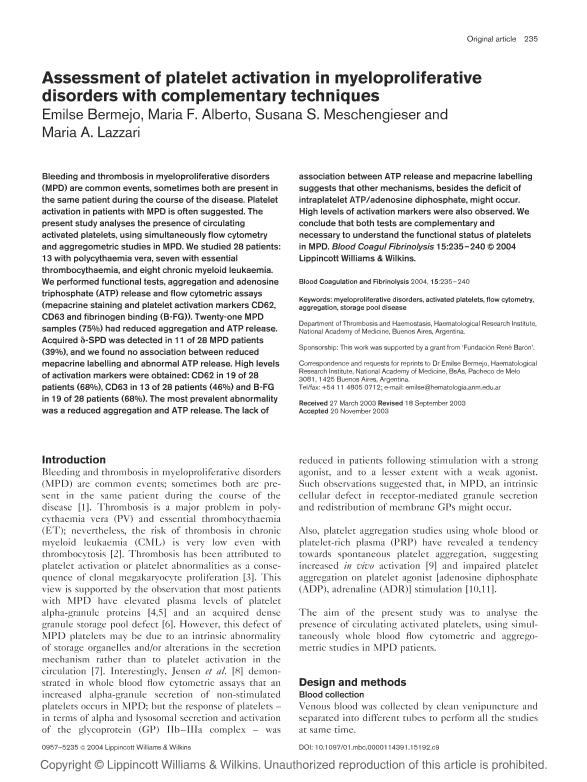Mostrar el registro sencillo del ítem
dc.contributor.author
Bermejo, Emilse
dc.contributor.author
Alberto, Maria Fabiana

dc.contributor.author
Meschengieser, Susana S.
dc.contributor.author
Lazzari, María Ángela

dc.date.available
2019-03-11T15:00:06Z
dc.date.issued
2004-04
dc.identifier.citation
Bermejo, Emilse; Alberto, Maria Fabiana; Meschengieser, Susana S.; Lazzari, María Ángela; Assessment of platelet activation in myeloproliferative disorders with complementary techniques; Lippincott Williams; Blood Coagulation & Fibrinolysis : An International Journal In Haemostasis And Thrombosis.; 15; 3; 4-2004; 235-240
dc.identifier.isbn
0957-5235
dc.identifier.issn
0957-5235
dc.identifier.uri
http://hdl.handle.net/11336/71329
dc.description.abstract
Bleeding and thrombosis in myeloproliferative disorders (MPD) are common events, sometimes both are present in the same patient during the course of the disease. Platelet activation in patients with MPD is often suggested. The present study analyses the presence of circulating activated platelets, using simultaneously flow cytometry and aggregometric studies in MPD. We studied 28 patients: 13 with polycythaemia vera, seven with essential thrombocythaemia, and eight chronic myeloid leukaemia. We performed functional tests, aggregation and adenosine triphosphate (ATP) release and flow cytometric assays (mepacrine staining and platelet activation markers CD62, CD63 and fibrinogen binding (B-FG)). Twenty-one MPD samples (75%) had reduced aggregation and ATP release. Acquired δ-SPD was detected in 11 of 28 MPD patients (39%), and we found no association between reduced mepacrine labelling and abnormal ATP release. High levels of activation markers were obtained: CD62 in 19 of 28 patients (68%), CD63 in 13 of 28 patients (46%) and B-FG in 19 of 28 patients (68%). The most prevalent abnormality was a reduced aggregation and ATP release. The lack of association between ATP release and mepacrine labelling suggests that other mechanisms, besides the deficit of intraplatelet ATP/adenosine diphosphate, might occur. High levels of activation markers were also observed. We conclude that both tests are complementary and necessary to understand the functional status of platelets in MPD.
dc.format
application/pdf
dc.language.iso
eng
dc.publisher
Lippincott Williams

dc.rights
info:eu-repo/semantics/openAccess
dc.rights.uri
https://creativecommons.org/licenses/by-nc-sa/2.5/ar/
dc.subject
Activated Platelets
dc.subject
Aggregation
dc.subject
Flow Cytometry
dc.subject
Myeloproliferative Disorders
dc.subject
Storage Pool Disease
dc.subject.classification
Inmunología

dc.subject.classification
Medicina Básica

dc.subject.classification
CIENCIAS MÉDICAS Y DE LA SALUD

dc.subject.classification
Hematología

dc.subject.classification
Medicina Clínica

dc.subject.classification
CIENCIAS MÉDICAS Y DE LA SALUD

dc.title
Assessment of platelet activation in myeloproliferative disorders with complementary techniques
dc.type
info:eu-repo/semantics/article
dc.type
info:ar-repo/semantics/artículo
dc.type
info:eu-repo/semantics/publishedVersion
dc.date.updated
2018-11-22T14:57:21Z
dc.identifier.eissn
1473-5733
dc.journal.volume
15
dc.journal.number
3
dc.journal.pagination
235-240
dc.journal.pais
Estados Unidos

dc.journal.ciudad
Philadelphia
dc.description.fil
Fil: Bermejo, Emilse. Academia Nacional de Medicina de Buenos Aires; Argentina
dc.description.fil
Fil: Alberto, Maria Fabiana. Academia Nacional de Medicina de Buenos Aires; Argentina
dc.description.fil
Fil: Meschengieser, Susana S.. Academia Nacional de Medicina de Buenos Aires; Argentina
dc.description.fil
Fil: Lazzari, María Ángela. Academia Nacional de Medicina de Buenos Aires; Argentina
dc.journal.title
Blood Coagulation & Fibrinolysis : An International Journal In Haemostasis And Thrombosis.

dc.relation.alternativeid
info:eu-repo/semantics/altIdentifier/doi/10.1097/00001721-200404000-00006
dc.relation.alternativeid
info:eu-repo/semantics/altIdentifier/url/https://journals.lww.com/bloodcoagulation/pages/articleviewer.aspx?year=2004&issue=04000&article=00006&type=abstract
Archivos asociados
